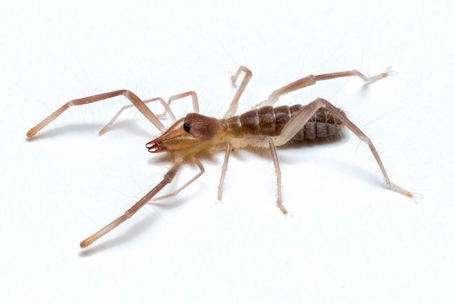Are Camel Spiders Poisonous?
Camel spiders are not poisonous.
Are Camel Spiders Venomous?
Camel spiders are not venomous. Camel spiders are actually not spiders, and as such, they have no venom glands and no mechanism to inject toxins. Their reputation comes from their intimidating size and speed, but biologically they rely entirely on strong, fast-moving jaws to overpower prey, not venom.
A bite from a camel spider can be painful because of those powerful jaws, but it does not involve envenomation and is not medically dangerous beyond normal wound-care concerns such as preventing infection.
Camel Spider Venom
Camel spiders do not possess venom, so there is no true camel spider venom to describe. They have no venom glands, no venom ducts, and no delivery structures. Their biology is built around powerful, scissor-like jaws rather than chemical weaponry. Because of this, anything described online as “camel spider venom” is a myth. The only risks from a bite come from the mechanical force of their jaws and the possibility of secondary infection, not any toxic substance.
Signs Of Camel Spider Envenomation
There are no signs of envenomation from camel spiders, because they do not produce or inject venom. If someone is bitten, any symptoms come strictly from the mechanical injury caused by their strong jaws, not toxins.
If a camel spider does bite, the only effects you might see are typical of a minor skin wound:
Sharp, immediate pain from the bite itself
Mild redness or localized swelling
Small lacerations or puncture-like marks
Possible minor bleeding
Risk of secondary infection if the wound isn’t cleaned properly
There are no systemic symptoms, no spreading pain, no neurotoxic or cytotoxic effects, and no systemic illness—because there is no venom involved.
What To Do About Camel Spider Envenomation
Since camel spiders cannot envenomate—because they have no venom at all—treatment is simply basic care for a minor bite wound. Here’s what to do if you’re bitten:
Clean the wound thoroughly: Wash the area with soap and water to remove dirt and reduce the risk of infection.
Apply an antiseptic: Use something like iodine or chlorhexidine to disinfect the bite site.
Control bleeding if necessary: Apply gentle pressure with a clean cloth or bandage.
Use a cold pack for pain or swelling: A cold compress can reduce discomfort and inflammation.
Cover with a sterile bandage: Keep the area clean and dry. Change the bandage daily.
Monitor for infection: Watch for increasing redness, warmth, swelling, pus, or worsening pain. These signs mean bacteria—not venom—are the concern.
Seek medical care if infection develops or if the bite is deep: A healthcare provider may prescribe antibiotics if needed.
Camel spider bites are mechanically forceful but not toxic, so once the wound is cleaned and protected, recovery is typically straightforward.

